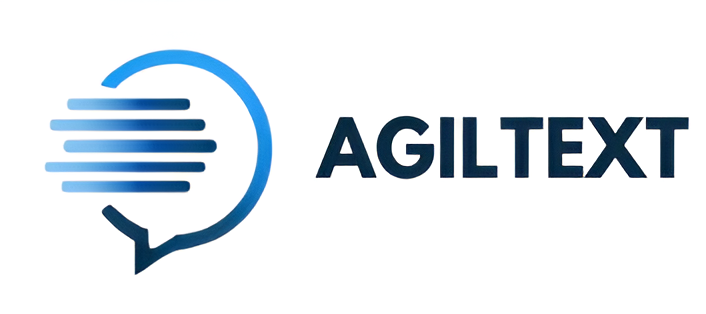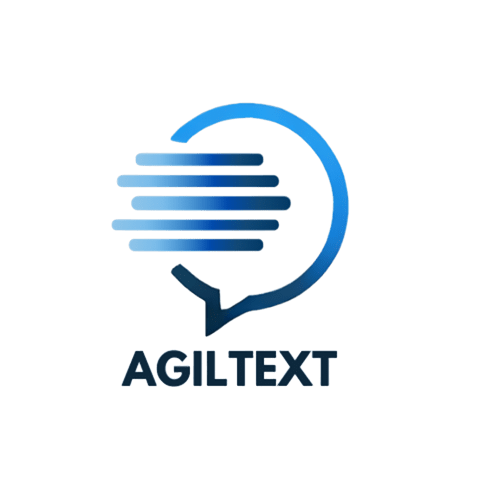Academic transcription has become a key tool in education. It offers multiple benefits that help both students and teachers to improve the learning and teaching process.
As educational practices evolve, it is important to highlight how transcription can facilitate accessibility, concentration and the creation of study materials. This makes its implementation increasingly relevant in today’s classrooms.

Importance of academic transcription
Live academic transcription plays a fundamental role in today’s educational environment. Its implementation provides a number of advantages that positively impact teaching and learning.
Evolution in education
With the advancement of technology and changes in teaching methodologies, academic transcription has taken on a prominent role. As more educational institutions adopt digital tools, the availability of transcripts has become a necessity. This not only benefits students, but also supports teachers in their educational work.
The digitization of classrooms and the use of online platforms have facilitated the recording and subsequent transcription of classes and lectures. This process has allowed institutions to adapt to a more inclusive educational environment, where the diversity of learning styles is catered for. In addition, the evolution of education towards a more accessible and equitable model is reflected in the growing importance of transcripts.
Impact on learning
The implementation of academic transcription has a significant impact on the way students learn and assimilate information. The ability to access lecture transcripts allows students to review content at their own pace and delve deeper into topics they deem necessary. This leads to greater retention of knowledge and improves overall comprehension of the study material.
- Facilitates the identification of key concepts in the content presented.
- It provides an additional resource for study, essential in preparation for exams.
- It promotes a more active approach to learning, as students can use the transcripts as the basis for their own notes and summaries.
The use of these transcripts is especially relevant for students with specific educational needs, who find in these documents a tool adapted to their requirements. Consequently, academic transcription not only benefits students in general, but also supports the progress of those who may face additional challenges in their educational process.
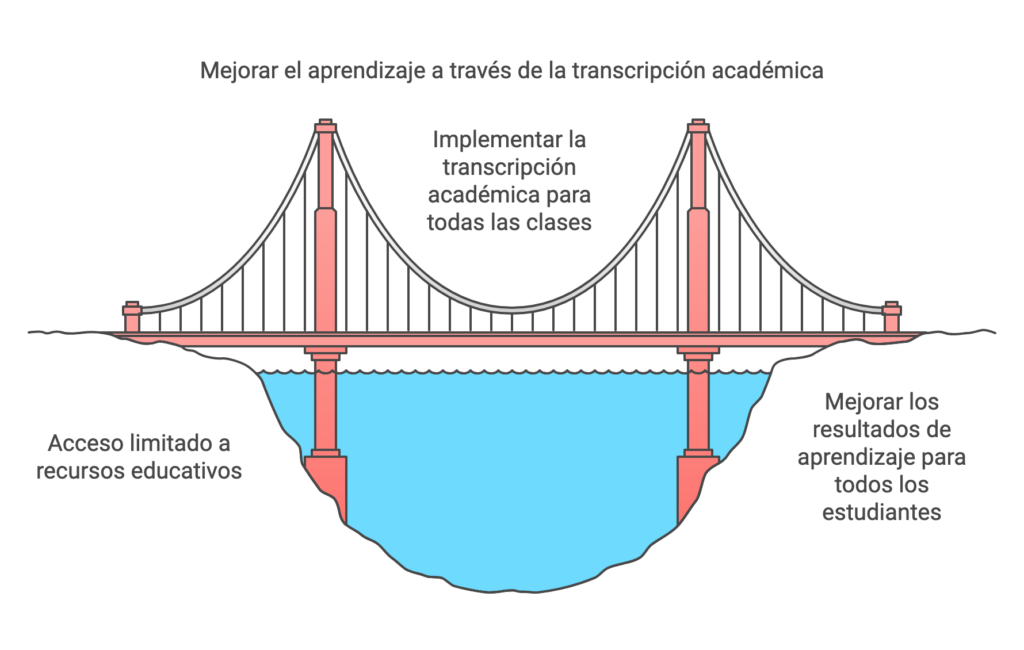
How transcripts improve concentration
Live academic transcripts are tools that promote a more efficient learning environment, enabling students to maintain their attention on the content presented in classes and lectures. The following are the main aspects of how Agiltext achieves this improvement in concentration.
Elimination of distractions
One of the main problems during lectures is the distraction that note-taking can cause. Many students are forced to divide their attention between listening to the lecture and writing, which can prevent proper absorption of the information. The availability of transcripts allows students to focus completely on the content, without worrying about writing down every word. This approach improves not only retention ability, but also comprehension of the material presented.
Benefits for different learning styles
Academic transcripts offer a valuable resource that accommodates the diverse needs and learning styles of students. By reducing the note-taking burden, they allow those with different learning preferences to fully benefit from the class.
Visual and auditory preferences
There are students who have an inclination towards visual learning. For them, having access to a written text allows them to better understand the information by being able to visualize concepts and relationships between ideas. On the other hand, learners with a more auditory learning style also find advantages in transcripts, as they can follow the thread of the conversation more easily and enjoy a more complete learning experience.
Active participation in class
Academic transcription encourages active participation. By eliminating the need to take notes, students can engage in discussions and ask questions without missing important details of the presentation. This type of classroom interaction not only enhances learning, but also fosters an environment where students feel more engaged in the educational process. An active approach in class is critical to the development of critical and analytical skills.
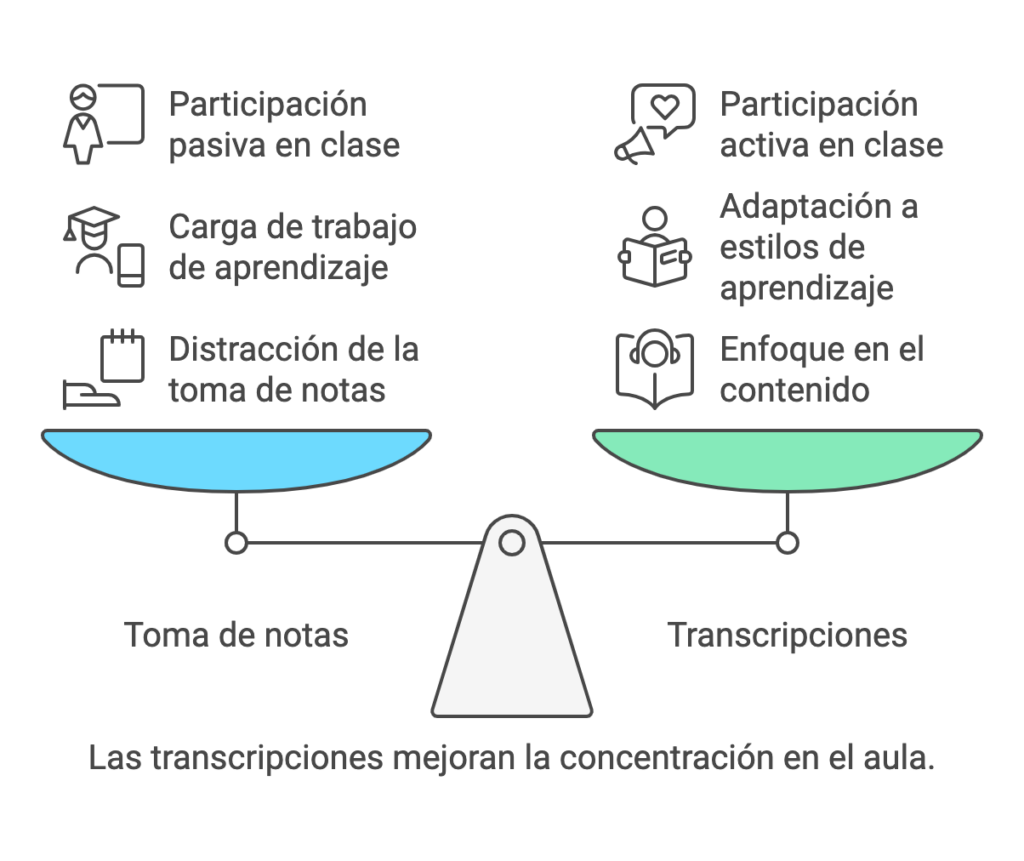
Accessibility and support for students with needs
Academic transcription is a fundamental tool to ensure accessibility in the educational environment. Its implementation allows students with specific needs to access content in an equitable manner.
Helping hearing impaired students
Academic transcription plays a crucial role in the inclusion of students with hearing disabilities. By providing the content of lectures and classes in written format, one of the most significant barriers these students face in their learning process is removed.
Regulatory compliance
Compliance with regulations such as the Americans with Disabilities Act (ADA) is essential in education. Transcripts not only help to comply with these regulations, but ensure that all students, regardless of their abilities, have equal access to information.
Inclusive educational environment
Thanks to transcriptions, classrooms can become more inclusive spaces. Students who are hearing impaired can keep up with the pace of lectures without missing key information, resulting in active and meaningful participation in their education.
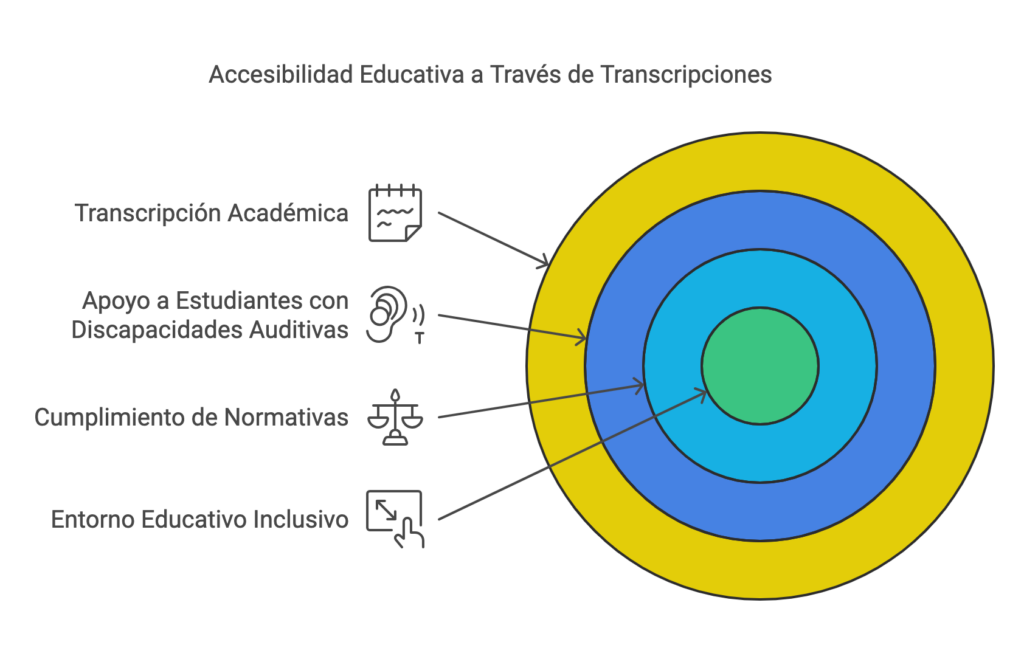
Support for international students
The accessibility of academic transcription also extends to students who are not native speakers of Spanish. For these students, access to transcripts provides them with a valuable tool to improve their understanding of language and academic content.
Providing transcripts in class allows international students to review the material presented at their own pace, which facilitates their adaptation to the local academic environment. This method is especially beneficial in situations where cultural differences can make learning difficult.
Advantages for ESL students
Academic transcription offers several specific advantages for students learning English as a second language (ESL). It facilitates language comprehension and provides resources that enrich their learning process.
Improved linguistic comprehension
Exposure to lectures and classes in English can be a significant challenge for ESL students. Many times, differences in pronunciation, accent and speed of speech make comprehension difficult. Transcripts allow these students to follow presentations more effectively. By having a written text at their disposal, they can connect what they hear to what they read, which increases their overall comprehension of the content.
This is especially beneficial during the learning of complex concepts. By reading the transcript, students can detail each idea and clarify doubts about the meaning of words or phrases that they did not fully understand when listening to them. This double exposure, auditory and visual, allows for a deeper internalization of the language.
Expansion of vocabulary and concepts
Transcripts not only facilitate comprehension, but are also valuable tools for expanding the vocabulary of ESL students. By being able to review the written content of the lessons, they can identify and focus their attention on words and expressions that are new or complicated for them.
- Frequent reading of transcripts helps students see how certain words are used in context.
- They can make notes and create vocabulary lists that allow them to practice and memorize new words.
- The context of the speeches provides them with examples that reinforce their understanding of how the terms are used in real situations.
Through this process, students not only acquire new vocabulary, but also develop communication skills that will be useful in both academic and everyday life. The ability to review the material at their own pace allows them to consolidate their knowledge and strengthen their confidence in using the language.
Utility in distance learning
Live academic transcription plays a fundamental role in distance learning, facilitating adaptation to new educational formats. It allows students to absorb and review content effectively, becoming an essential tool to optimize the learning process.
Efficient time management
Distance learning involves challenges related to time management. Students must be able to organize their study effectively to make the best use of available resources. Academic transcripts provide the flexibility necessary for learners to access information when they want it and at their own pace.
With transcripts, students can:
- Quickly catch up on any classes that have been missed.
- Focus on key concepts without having to replay long recordings.
- Create a more structured and personalized study plan, allowing them to prioritize the topics they need to review.
Support with technological tools
The integration of academic transcription with technological tools has become a crucial aspect of distance education, and this is where Agiltext can help break down all those barriers by allowing students to easily access transcribed content that complements their courses.
Integration with conferencing platforms
Videoconferencing platforms, such as Agiltext, have made it easier to conduct online classes. Many of these tools offer automatic transcription services, which transform recordings into understandable text that students can refer to after the sessions. This significantly improves the accessibility of content, allowing students to concentrate during class without the pressure of taking extensive notes.
Access to online content
Access to online transcribed content provides students with the opportunity to review relevant materials at any time. This is especially valuable for those who have work or family responsibilities that prevent them from attending all regularly scheduled classes.
Transcripts allow students to:
- Search and access specific information quickly.
- Prepare their work more efficiently by having access to the content discussed in class.
- Increase retention of information, resulting in better academic results.
Creation of study materials
Academic transcription plays a key role in creating effective study materials. It provides students with structured content that facilitates learning and review of key information.
Development of guides and summaries
Transcripts provide a solid foundation for the development of study guides and summaries. Students can extract relevant information, organize it, and present it in a clear and concise manner. This process helps consolidate knowledge and efficiently prepare for exams.
The study guides may contain:
- Key concepts: Summary of the most important concepts addressed in the classes.
- Direct quotations: Inclusion of textual quotations that reinforce arguments and add credibility to academic papers.
- Practical exercises: Proposals of exercises related to the content to promote active learning.
In this way, the transcripts not only serve as a review, but also promote a deeper understanding of the topic being studied. Access to well-structured content allows students to prepare equitably, regardless of their ability to attend live classes.
Equal access to knowledge
Academic transcription ensures that all students have equal access to information. In contexts where there is a diversity of abilities, transcripts make it easier for each individual to study and understand the subject matter at his or her own pace.
This translates into several significant benefits:
- Elimination of inequalities: Students who are unable to attend classes or need to review content can access the same resources as their peers.
- Reinforcement of learning: The transcribed resources allow students to review the material at times that are most convenient for them.
- Promoting autonomy: Students develop self-learning skills by being able to manage time and resources effectively.
Thus, the creation of study materials from transcripts contributes to a fairer and more accessible educational environment. Equal access to knowledge is fundamental to the positive academic development of all students.
Role in academic research
Academic transcription plays a crucial role in the field of research, facilitating the collection and analysis of meaningful data by allowing more efficient access to information. This resource is beneficial for both researchers and students seeking to further their areas of study.
Facilitates information gathering
Real-time transcripts in academic research allow researchers to accurately capture the content of interviews, seminars, and focus groups. By recording these interactions in written format, the difficulties associated with the note-taking process are eliminated. This results in richer and more detailed material, which in turn makes for a more effective research environment.
Improves analysis and synthesis
The possibility of having transcripts of research sessions gives scholars the opportunity to analyze the content in a more in-depth manner. By having the data in written format, terms and concepts can be searched much more efficiently.
Extraction of quotations and references
Transcripts make it easy to quickly locate relevant citations, which is especially useful when writing academic articles and reports. This access to specific content allows researchers to support their arguments and analytics based on direct sources of information.
Quality in the presentation of results
The ability to integrate accurate and consistent citations into research reinforces the quality and credibility of the results presented. By using transcripts, a more rigorous approach to the presentation of results is promoted, resulting in papers of greater impact and relevance in academia.
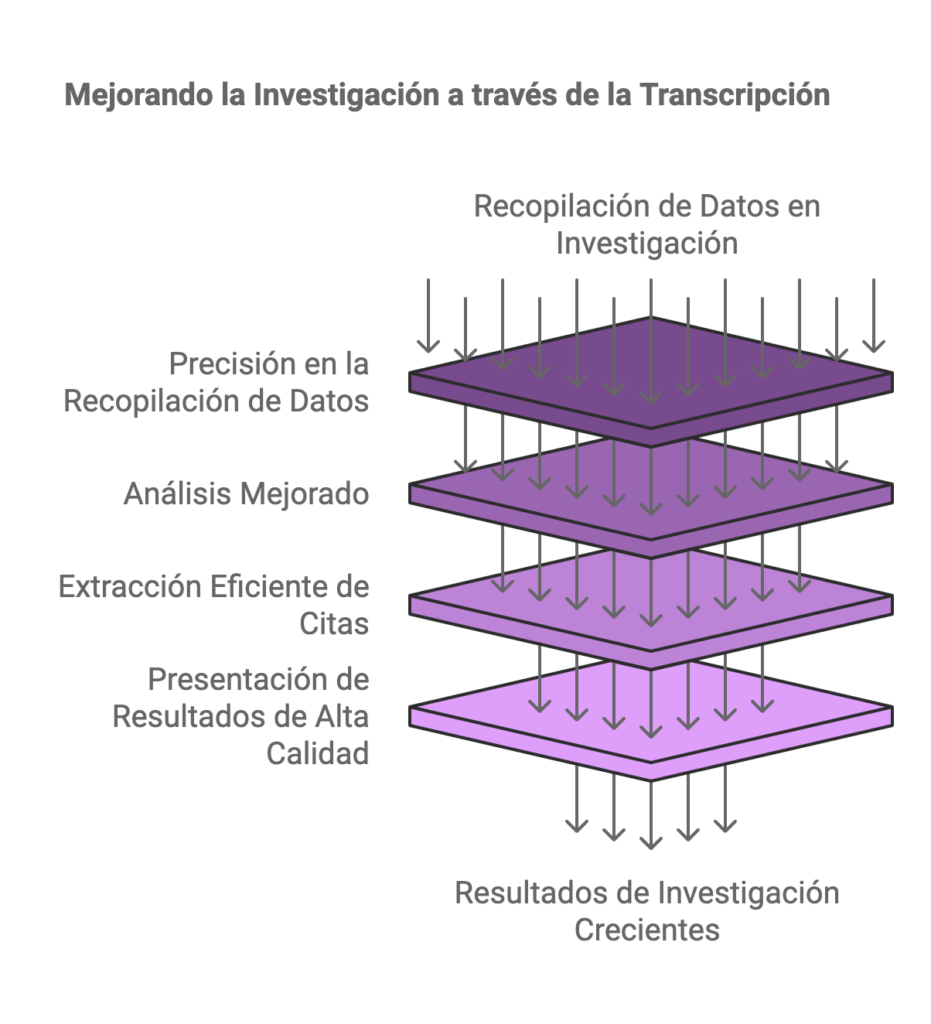
Efficient and accessible information search
Real-time academic transcription facilitates the search for information through its written format. This resource transforms the way students and academics access valuable content, significantly optimizing study and research.
Advantages over audio and video files
Audio and video files can be limiting in terms of searching for and retrieving specific information. Transcription offers numerous advantages, including:
- Direct access to key terms: By having a text, it is possible to search for words or phrases without having to listen to the entire content. This saves time and effort in locating relevant concepts.
- Ease of reference: Transcripts allow students to easily cite and reference the material in their academic work, which is difficult with audio or video files.
- Clarity of content: A transcribed text eliminates possible confusion that may arise from aural interpretation, thus facilitating an accurate understanding of the terms and definitions used.
Academic integrity in written work
The use of transcripts not only provides simplified access to information, but also reinforces academic integrity. This is achieved in the following ways:
- Accurate citation reference: By having a complete transcript, students can incorporate direct quotations accurately and with correct attribution of authors, strengthening the validity of their arguments.
- Reduced plagiarism: The ability to consult and cite properly reduces the possibility of plagiarism, since students can construct their own analyses from truthful and well-referenced sources.
- Fostering originality: With access to diversified information, students are better equipped to generate original content in their academic papers, gradually developing their own writing voice and style.
